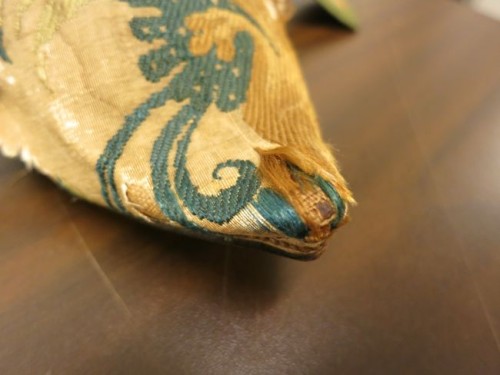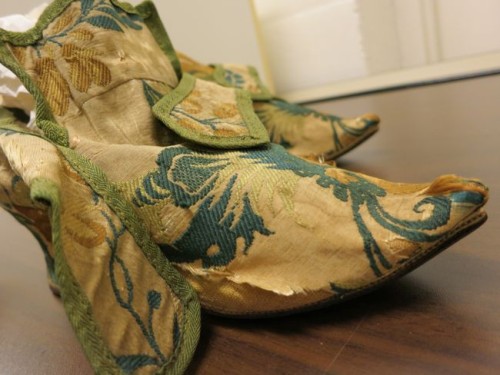I wish I had a finished garment to show you today – my hoopskirt, or the hinted at 1900s dress, but sewing is not going to plan, and I want to post about at least SOMETHING, and I thought, hey, a real antique textile is as good as anything I make, if not better!
I’ve shown you most of the textiles from the Honolulu Museum of Art, but here is one of the most exciting pieces I looked at: a pair of 18th century shoes in green and gold on ivory brocade:
Based on the large scale brocade, which is clearly early 18th century in date, the wider heel shape and slightly tilted toe, the shoes are probably early-mid-18th century.
The outer of the shoes are silk brocade, and they are lined in linen. The green binding is herringbone twill, either in cotton or linen. The shoes are (obviously) entirely hand sewn. The heel is wood, covered in more of the brocade, and the sole is rather heavy leather.
The pointed toe appears to be supported by more leather, carved into the little tilted point.
The heavy leather sole has an interesting star shape stamped into it near the toe, and again near the heel. I presume it had something to do with the construction, but couldn’t figure out exactly what. Anyone else seen a similar thing?
The silk brocade of the shoes is pieced on the tongue, where it will be hidden by the flaps. It may be to save fabric, but I think it is more intentional: to help with the shaping transition from the front of the shoe to the tongue, and possible to ensure a pretty placement of fabric pattern on the tongue, where it would be seen.
There was other piecing that is clearly to save fabric, or to repair the shoe after a bit of wear, though the lack of in-period wearing makes that seem unlikely.
The interiors have quite a bit of piecing, but it is all essential construction. There is extra white kid leather in the heels, where the shoes will get more wear.
The shoes don’t appear to have had much wear, but they are still in quite aged, fragile condition. The silk brocade is particularly brittle and friable, and has disintegrated entirely in places, which is sad from a condition viewpoint, but extremely helpful from a research viewpoint, because it allows us to see into the construction. It may have been done to save
The shoe was so fascinating that I took TONS of photos of all the details, which I hope you will also find interesting. I won’t bore you with a commentary on all the images, but do ask if you have any questions.
If you want to see more textiles from the HMA, I’ve posted about an early 19th century dress, an amazing embroidered cisele velvet 18th century man’s suit, a late 19th century Turkish tea robe that had been altered for wear by a Western woman, and a teaser-taster of all the textiles.
















Could they have been notches to better fit the metal patterns on, under the shoe, to be tied over. Patterns were used in bad weather to keep dainty shoes and low hemlines out of the dirt.
I don’t think so. They are very shallow – you’d barely feel them if you brushed your fingers over them, and I can’t imagine they would be any help in holding on a pair of pattens.
Interesting about the little stars on the sole! My first thought was “maker’s mark” but I have no idea if that was done on shoes in period.
I thought ‘makers mark’ for a moment too, and then realised that there were two, and that they are at vital connection points in the sole, so something to do with the construction seemed more likely.
digitaltmuseum.seThese Swedish shoes from the 18th century are supposed to have “six star-shaped marks on the sole”. They are not pictured, though!
http://www.digitaltmuseum.se/things/skor/S-NM/NM.0002140A-B?query=skor&search_context=1&rows=24&sort_by=&type_filter=Thing&Thing_subject_filter=Dr%C3%A4kt+:+Skodon+:+Skor&js=1&page=2&count=134&pos=27
Oh, how interesting! It sounds like exactly the same thing. I wonder if they have 6 marks per shoe, or 6 marks for the pair: so three per shoe?
Yes, that isn’t very clear in the original description I’m afraid!
This is a guess. I know most of the work on a shoe is done with the shoe upside down on the last, but at some point, the shoe must be worked on right side up, so one way of holding it firmly would be to clamp it. Possibly double clamp it. The clamp section inside the shoe would have to be smooth or padded for later comfort, and to avoid damaging delicate linings, but the section on the sole would need to be less smooth, even with a little star shape, to hold the shoe firmly. My guess would be that there would have been one clamp, shifted according to the area worked on.
I wonder if these only occur on shoes with turned-up toes? Because the two clamp marks (see – I’m assuming!) might have been made when the sole was clamped to make the curve. The sole would have been flat when cut, and would have to be bent to shape. Probably bent damp, which would increase the possibility of a lasting star mark. You can imagine it – put the clamps on, move them closer together to achieve the desired bend, and leave clamped overnight to the bench to dry.
That’s very much along the lines of what I was thinking: that, or a star-shaped punch/hammer.
Thanks for these close-up pics! In our fieldschool report, I did the analysis of the early 18th c leather shoes we found at the shipwreck excavation, so since then I’ve been fascinated with constructional details of shoes!
Love the piecing and the leather re-inforcement details. And the leather in the pointed toe. And the worn brokade. And the tounge construction. (So, all in all, fantastic shoes!) Really interesting to see, thanks!
The two star marks are to close the nail holes in the sole. You tack the leather to the last in those two (sometimes three in a triangle) places. That stamp, along with a little bit of wax in the hole, closes the hole back up to keep water from coming in. The stamp is often unique to the shoemaker.
This is a wonderful post! I love seeing this much detail. Interesting that they put the whittaw toe reinforcement on the interior rather than sandwiched between the lining and outer. I was taught that way, though I’m finding more and more exposed. Interesting because you would have to reinforce before lasting, making the lasting allowance based on guess work.
As for dating, they’re most likely 1730s and vaguely French.
Oh, and both piecing of the tongue and piecing of the straps are very commonly done to save fabric. Those portions stick out from the main body when patterning. I’ve been told that piecing the tongue tends to be more French than English, at least on leather shoes. I haven’t studied enough fabric shoes to verify that it carries over yet, but the toe shape on these does lend itself to being more French.
Amazing how accurately these shoes were done with just simple tools and handwork, not as today they do.